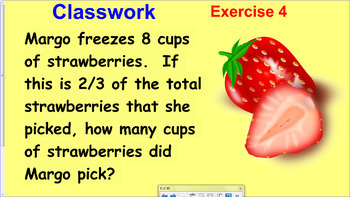Engage NY (Eureka) 6th Grade Common Core Entire Math Module 2- Topics A - D
Michelle Sylvester
528 Followers
Resource Type
Standards
CCSS6.NS.A.1
CCSS6.NS.B.2
CCSS6.NS.B.3
CCSS6.NS.B.4
Formats Included
- Zip
Pages
593 pages
Michelle Sylvester
528 Followers
Description
If you love Engage NY, but are looking for a more engaging way to teach the modules, you have come to the right place! This notebook file for SmartBoard follows the 6th grade Module 2, Topics A- D, Lessons 1-19. If you like these lessons, follow me for full topic and module notebooks for other grades. Save time and energy while engaging students in common core math! These topics and lessons cover arithmetic operations including division of fractions. Engage NY created the modules, I made them easier to follow and more interesting for students. SAVE $$ by purchasing the whole module! You must have Smartnotebook software for SmartBoard to open!
Total Pages
593 pages
Answer Key
Included
Teaching Duration
1 month
Report this resource to TPT
Reported resources will be reviewed by our team. Report this resource to let us know if this resource violates TPT’s content guidelines.
Standards
to see state-specific standards (only available in the US).
CCSS6.NS.A.1
Interpret and compute quotients of fractions, and solve word problems involving division of fractions by fractions, e.g., by using visual fraction models and equations to represent the problem. For example, create a story context for (2/3) ÷ (3/4) and use a visual fraction model to show the quotient; use the relationship between multiplication and division to explain that (2/3) ÷ (3/4) = 8/9 because 3/4 of 8/9 is 2/3. (In general, (𝘢/𝘣) ÷ (𝘤/𝘥) = 𝘢𝘥/𝘣𝘤.) How much chocolate will each person get if 3 people share 1/2 lb of chocolate equally? How many 3/4-cup servings are in 2/3 of a cup of yogurt? How wide is a rectangular strip of land with length 3/4 mi and area 1/2 square mi?
CCSS6.NS.B.2
Fluently divide multi-digit numbers using the standard algorithm.
CCSS6.NS.B.3
Fluently add, subtract, multiply, and divide multi-digit decimals using the standard algorithm for each operation.
CCSS6.NS.B.4
Find the greatest common factor of two whole numbers less than or equal to 100 and the least common multiple of two whole numbers less than or equal to 12. Use the distributive property to express a sum of two whole numbers 1–100 with a common factor as a multiple of a sum of two whole numbers with no common factor. For example, express 36 + 8 as 4 (9 + 2).





